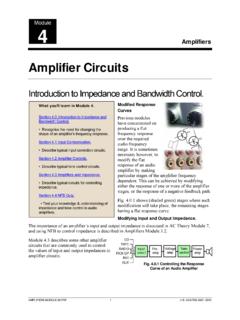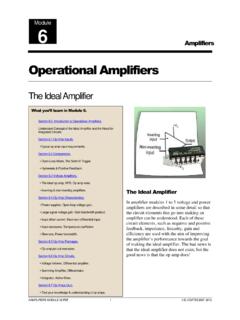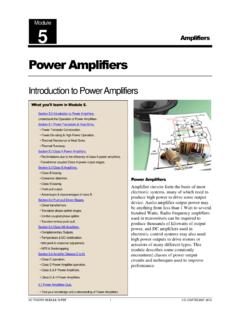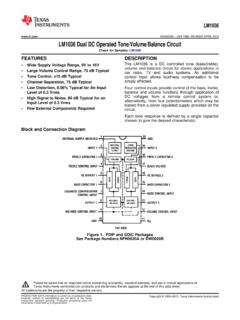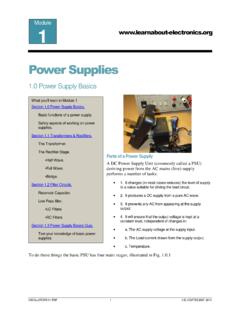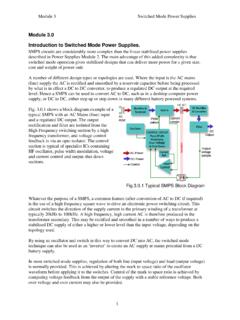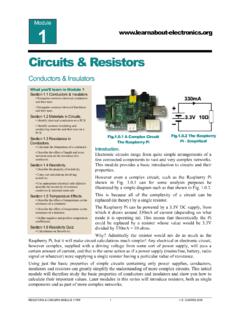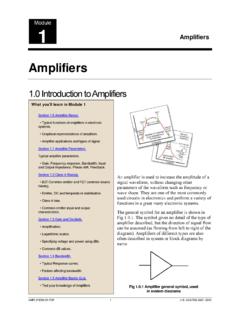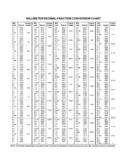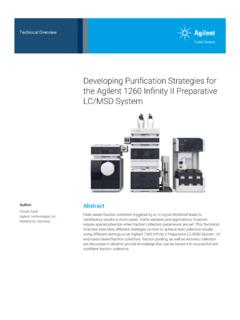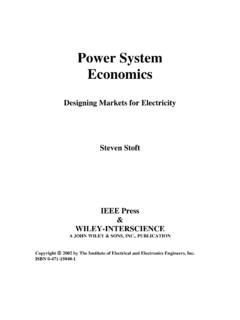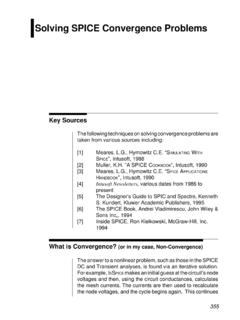Transcription of Maths tips v2 - Learn About Electronics
1 ElectronicsMaths TipsUsing a Scientific Calculator for Electronics Calculations Version Maths tips 2 Version This booklet will Things to look for when buying an electronic calculator for Electronics . Powers of ten and express numerical values for units in standard form for multiples and submultiples The use of SI prefixes with electrical units: mega kilo milli micro nano pico The relationships between quantities: V=IR P=IV etc W=Pt Decimal places, significant figures, squares, ratios, and averages Transposing basic Electronics formulae for calculations. Basic Trigonometry Contents Introduction..3 Buying a scientific calculator: ..4 Calculators with QWERTY (typewriter style) keyboards and DATA BANK models.
2 4 Programmable models and palmtop Graphical display models and phone apps ..4 Decimal Numbers..5 Powers of Ten..5 Standard Form..7 SI Units with multiples and sub-multiples commonly encountered in Electronics ..10 Significant Figures ..11 Squared Numbers ..11 Reciprocals ..12 Ratios ..12 Averages ..12 Finding unknown Using the "triangle method" for the formulae SOH CAH TOA ..14 Finding an unknown angle..15 Facts and Formulae for Resistor Calculations ..16 Maths tips 3 Version Introduction. Electronics , like most other branches of science and technology involves mathematics. Some of the Maths used for Electronics calculations are very complex. This does not mean however, that in Electronics servicing there is a need to get too involved with complex mathematical problems.
3 The reason for this is that, unlike Electronics design engineers, the problems facing SERVICING personnel are with circuits and equipment that have already been designed and built, and which have been working properly. The Maths has already been done and so doesn't really concern the servicing technician. What is chiefly necessary is to understand Electronics circuits, their components and the basic principles that make them work. To properly understand circuits and their principles a certain amount of calculation is needed, this basic guide will therefore concentrate on examples of mathematical calculations necessary for Electronics servicing, and in particular the use of scientific calculators in solving these problems. Maths tips 4 Version Buying a scientific calculator.
4 Calculations in Electronics need a scientific calculator, not the one on your mobile phone or your digital watch! There are many types to choose from so here are a few tips to help you choose the right model. Don't spend too much! There are many suitable scientific calculators and prices range from quite cheap to "Forget it!" Remember, spending too much simply buys extra functions you won't use. Generally, for the Maths you need for Electronics servicing or anything other than advanced Electronics , you won't need a top of the range calculator: Calculators with QWERTY (typewriter style) keyboards and DATA BANK models. If you are planning to take formal exams, you will find that many examining bodies ban their use in exams and they are far more complex than you need. Programmable models and palmtop computers. You will find that you will spend more time learning to program the calculator than it would take to do the calculation with a much simpler model.
5 Graphical display models and phone apps. You will mainly use it to show off to your friends. Functions to look for: Whatever you use, your calculator should have these keys: EXP or EE (exponent key ) ENG (engineering notation) x2 (square) x(square root) x1 or x-1 (reciprocal) xy or yx (powers) log & ln (logarithms) sin cos tan (trigonometrical functions) In addition it will be helpful if your calculator will accept numbers in number systems such as; BIN OCT HEX (Binary - Octal - Hexadecimal) All these features and more are found on inexpensive scientific calculators. If you are not sure what to buy for use on a particular Electronics course, your tutor will be happy to give you advice - just ask. Maths tips 5 Version Decimal Numbers.
6 Decimal numbers are very familiar in everyday life. They are used to express most of the quantities in everyday use. Money, ages, street numbers, weight and quantities are all expressed in decimal numbers. A decimal number is written in COLUMNS, each column having a value that is a multiple of TEN 15 is a decimal number which means 1 TEN & 5 UNITS 124 means 1 HUNDRED + 2 TENS + 4 UNITS The right hand most figure is called the LEAST SIGNIFICANT FIGURE because it has the smallest value, and the left hand most figure the MOST SIGNIFICANT FIGURE because it has the largest value MOST SIGNIFICANT FIGURE >1 2 4< LEAST SIGNIFICANT FIGURE Fractions can be expressed using decimal numbers, by placing a decimal point . between the whole number part (called the INTEGER) and the fractional part (called the FRACTION) of a number Means; Powers of Ten. The figures to the LEFT of the decimal point represent increasing powers of ten, moving column by column left from the decimal point, for example, can be written as a series of powers of ten, so 1456 can be written as: (1 x 103) + (4 x 102) + (5 x 101) + (6 x 100) Although this may seem a laborious way to write a number, the idea of using powers of ten is extremely useful.
7 So much so that calculators have a special key that helps in entering numbers this way. More About this later, but firstly it is important to understand what these powers of ten mean; 103 means 10 x 10 x 10 (10 multiplied by itself 3 times) 1000 (1 followed by 3 noughts) 102 means 10 x 10 (10 multiplied by itself 2 times) 100 (1 followed by 2 noughts) etc. Therefore is; (1 x 1000) + (4 x 100) + (5 x 10) + (6 x 1) 5 TENS + 6 UNITS + 2 TENTHS + 5 HUNDREDTHS Integer Fraction . Decimal point Maths tips 6 Version Writing the fractional part of a number can be carried out in a similar way, but this time the powers of ten have NEGATIVE values. can be written (2 x 10-1) + (5 x 10-2) + (6 x 10-3) Where 10-1 means 1/10 10-2 means 1/100 10-3 means 1/1000 etc.
8 WHY use this method of writing numbers? Well, Electronics uses a very wide range of numbers. Some radio frequencies may have values of many millions of Hertz (the standard unit of frequency) 500,000,000 Hz While the values of some components may be expressed in very small numbers. A capacitor could have a value of only a few millionths of a millionth of a FARAD (the standard unit of capacitance) Farad To avoid having to read or write these very long numbers, they can simply be written as powers of ten. Number Written as; 1,000,000 106 100,000 105 10,000 104 1,000 103 100 102 10 101 1 100 1/10 10-1 1/100 10-2 1/1,000 10-3 1/10,000 10-4 1/100,000 10-5 1/1,000,000 10-6 1/1,000,000,000 10-9 1/1,000,000,000,000 10-12 Using this system, becomes 5 x10-6 and 500,000 becomes 5 x 105 Using very small, or very large numbers such as these is made much easier by using a scientific calculator.
9 A typical calculator keypad has a key marked or This key is used to avoid having to key in " x 10 " every time. Maths tips 7 Version For example, the number 500,000 or 5 x 105 is entered by pressing just three keys; or The display will normally show something like - 5 05 or 5E5 (different models may have slightly different displays) Note that this is 5 x 105 (5 followed by 5 zeros) and NOT 55 (5 x 5 x 5 x 5 x 5) ( millionths) would be entered as Note the use of the +/- key (change sign key) on the calculator when to a NEGATIVE POWER of ten is required. ( some calculators use different versions of the change sign key. For example (-) or even just -. Consult your calculator instructions for more information.) When correctly entered, our display should show something like; -06 or - 6 Standard Form.
10 Electronics quantities need to use powers of ten (or EXPONENTS as they are called) with standard electrical units such as the OHM, the AMPERE etc. These units however, are normally using a system of standard prefixes. For example the standard prefix for 1000 volts is 1 kilovolt. The following table lists some of the common prefixes used in standard electrical units. Their names usually derive from a suitable Greek or Latin word. Note that it is very important to use the correct capital or lower case letter when using the abbreviated version of these units. For example, M means mega- (a million) whilst m means milli- (one thousandth). If the result of an otherwise correct calculation simply used M instead of m in the answer, it would be not just be wrong - it would be 1,000,000,000 times bigger than it should be! Because of the enormous range of sizes of electrical units this apparently stupid answer could also be mistaken for a correct answer.
